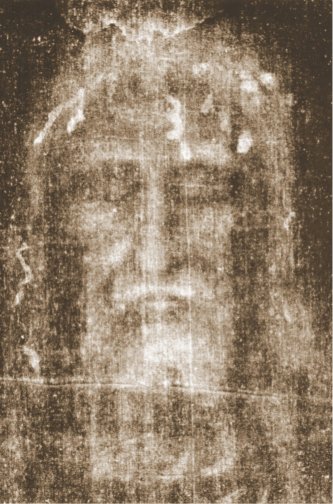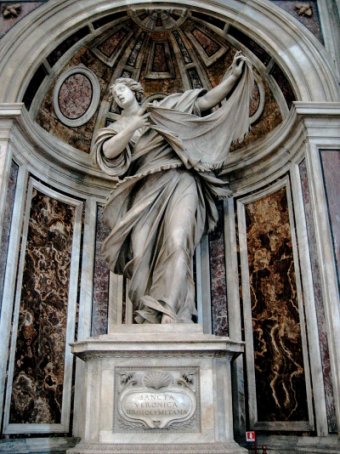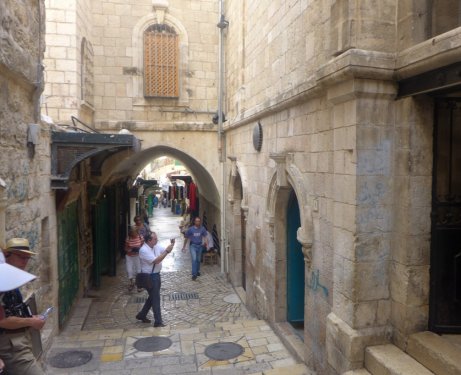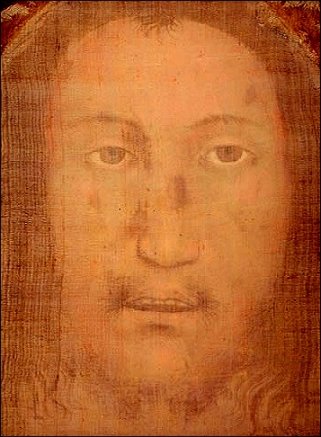What makes a work
of art Sacred? The subject matter, of course, but ancient tradition goes
much further than that. Some artworks, it was said, have miraculous
properties. Gabriele Paleotti, 16th
century archbishop of Bologna, defined what those special properties
were in 1582:
An image is
called sacred if it enters in to contact with the body or with the face
or with other parts of our Lord or one if his saints, where, just by
means of that contact, the figure of the body or the part of the body
that was touched is printed there.
An image is
called holy that would be made by a holy person, like those made by St
Luke or painted by other saints.
An image is
called holy because it was made in a miraculous manner, that is, not by
the hand of man but invisibly, by the work of God, or by other similar
means.
An image is
called holy when God has performed manifest sounds and miracles in that
image, as are seen at times with the face radiant, at times with tears
spilling from the eyes, or drops of blood, or they make some movement as
if they were alive: also God, through them, has, in an instant, healed
the sick, restored vision to the blind and liberated others from various
dangers.
To the modern
sceptic this is nonsensical, but nevertheless, the tradition is a
fascinating one. In this study I’ll be looking at a range of artworks
that match the archbishop’s criteria, and asking the question, could
some strange truth be lurking behind these beliefs?
I will divide the archbishop's final holy definition into two
parts; images that produce sound or make movements, and images that work
miracles.
1. Miraculous by touch
The two best known examples of this are the Turin Shroud and the Veil of Veronica. We'll look at these two relics here.
The Turin Shroud


Opinions still rage over
the Shroud of Turin, said to be the burial shroud of Jesus. There is no
history of it before the mid fourteenth century, and some were
suspicious of it even then.
Recent scientific analysis
has cast much doubt on the claimed provenance. Radiocarbon dating dates
the shroud to c1260, though some still argue that this is due to later
contamination. Perhaps the most decisive denial of the legend is the
material used to make it, which is woven in a manner far advanced from
that used in biblical times.
There is still, however, a
question about the shroud that cannot be answered – how the image
appeared (or was put) on the shroud. It remains a much-venerated relic.

Statue of Veronica and the Veil, St Peter's Rome

Via Crucis Station 6
The story of the Veil of Veronica comes from various confusing medieval
legends. It was said that a woman named Veronica wiped the sweating face
of Jesus as he carried the cross, and a miraculous image appeared on the
veil. It occurred at the sixth station of the Via Dolorosa in Jerusalem
– see my photograph above. The legend continues; Veronica then took the
veil to Rome and used it to cure Emperor Tiberius.
Was there really someone called Veronica? It is suggested that
the name was formed from the Latin word ‘vera’ (truth) and the Greek
word ‘eikon’ (image).
Its presence in St Peter’s Rome is shrouded in mystery. A
‘Veronica chapel’ was in place in the early 8th century, though the
first mention was in 1101. By the third century the veil was annually
paraded through Rome.
Now was it destroyed during the sack of Rome in 1527? Was it
taken elsewhere – there are a number of relics claiming to be the
original in various places. Or is it still in St Peters? A relic there,
said to be the veil, is displayed once a year in Lent, though there is
no discernible image.
Below is one of the relics from elsewhere, the
one with the best image; The Manoppello Image, now in a church in
Manoppello in Italy.

On to page 2